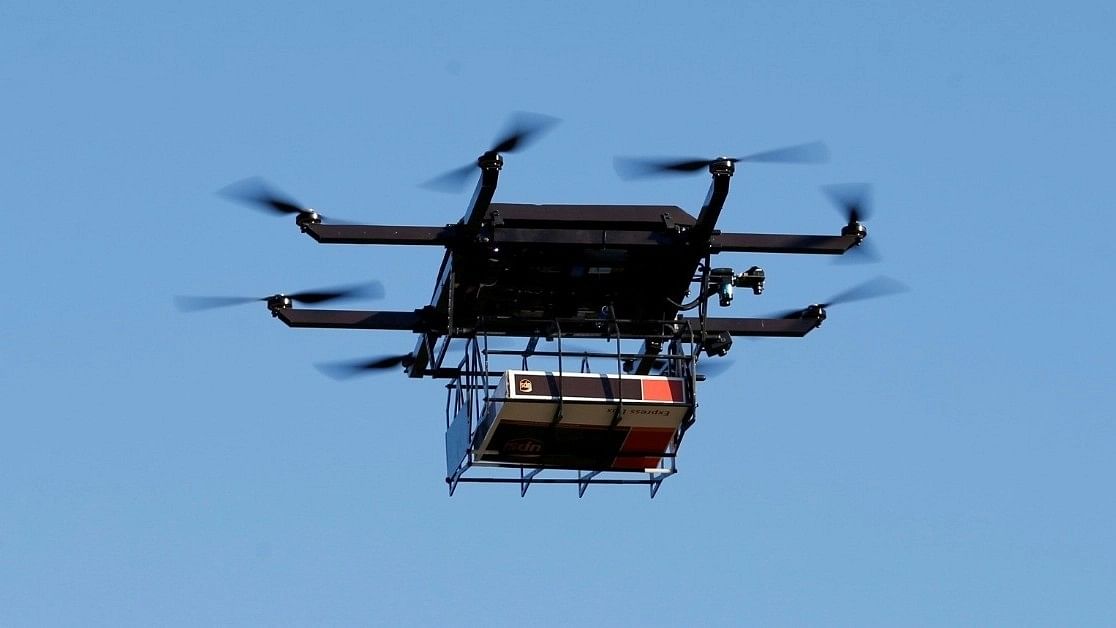
Representative image of a drone.
Credit: Reuters Photo
By Thomas Black
The US has been a dominant player in aerospace ever since engine-powered flying machines took to the skies more than a century ago. From warplanes to airliners to private jets the US has been a leader in the industry. The US government put men on the moon, and private US companies, with SpaceX out front, will most likely be the first to get people to Mars. US companies are also rushing to compete in the large electric vertical takeoff and landing aircraft, known by the unfortunate acronym EVTOLs.
There is one chief exception to the US’s aerospace leadership: small commercial drones.
Chinese companies dominate this market. Da-Jiang Innovations, or DJI, has a commanding lead, followed by Autel Robotics, another drone maker championed by the Chinese government. These drones are mostly quadcopters, which have four or more electric motors and carry cameras, thermal sensors, ground penetrating radar and other gadgets. Insurance companies have found them valuable to assess damage. Railroads fly them around bridges for safety inspections. Construction companies can take quick inventory from the air. Film companies love them because they are cheaper and easier to use than helicopters.
They also have a military use, as Russia’s war on Ukraine has demonstrated. Platoons usually have a member who packs a drone to launch and reconnoiter enemy positions. Resourceful soldiers even strap on a grenade to first-person view drones, which are popular with drone-racing enthusiasts, and use them as weapons. Dramatic photos of these drones detonating on transport trucks and even tanks have spread on the internet.
The Pentagon and Congress are now sufficiently alarmed at how far behind the US trails on manufacturing commercial drones that the American Security Drone Act, which bans federal agencies and contractors from using Chinese drones, was signed into law in December. The Defense Department also introduced a procurement program called Replicator, which is designed to spur homegrown production of drones. These steps should help tilt the playing field back to level.
The Chinese takeover of the commercial drone industry wasn’t an accident, according to industry trade group Association of Uncrewed Vehicle Systems International, or AUVSI. With the help of government subsidies, Chinese drones have flooded the global market.
“The results of Chinese drone dumping have been devastating to the US drone manufacturing industry,” the trade group said in a January study. Chinese drones command about 90% of the US consumer market and 70% of the industrial one.
US drone makers were decimated early by the onslaught of cheaper, and frankly, more capable DJI and later Autel drones. The DJI Phantom 4, which came equipped with a great camera and object-avoidance technology, profoundly changed the industry when it was introduced in 2016.
The problem has its roots with China’s entrance in 2001 into the World Trade Organization, which opened the once-closed Asian country for business. The hope was that after China joined the rest of the trading world with a market-based economy, its political system would also open up and allow for the free flow of ideas that drive innovation and competitiveness. That hope has been dashed slowly as China never opened its domestic economy fully to foreign competition, failed to protect intellectual property and coerced technology transfers by requiring partnerships with local companies. The lost hope is almost complete with the increasingly hardline taken by President Xi Jinping.
Russia’s war on Ukraine is a wake-up call on the dangers of letting an unfriendly nation dominate the drone market. Both sides are deploying thousands of Chinese drones, said Stacie Pettyjohn, a senior fellow at the Center for a New American Security.
“Most of the drones are pretty cheap, and you’re seeing a lot of them lost,’’ said Pettyjohn, who wrote a report on drone use in the conflict. “They’re being used like munitions.’’
The US is a leader for large, long-range drones, including General Atomics’ MQ-9 Reaper and Northrop Grumman Corp.’s MQ-4C Triton. These are more like airplanes and are as sophisticated as they are expensive. These drones are crucial for the long-range missions that would likely be required in a sea conflict, such as one involving Taiwan, Pettyjohn said.
With the government assistance, US manufacturers can get back in the game on the smaller and less costly drones. Skydio, the largest US producer of commercial drones, has expanded its factory in Hayward, California, and expects the higher production to help drive down costs. The company’s latest drone, the X10, has closed the capability gap on DJI, said Mark Valentine, Skydio’s president and general manager of global government.
“We’re a little bit more expensive than a DGI system,’’ Valentine, whose team has been to Ukraine 17 times in the last year, said in an interview. “We now beat them when it comes to features, whether that’s sensor capability, software capability and connectivity.’’
Some US companies are concerned that the restrictions on Chinese drones will keep them from using the best-performing machines at the lowest cost. They argue that they can secure their data from being misused by Chinese drone makers.
While it would be a step too far to ban Chinese drones completely from the US market, it’s important that US drone makers increase production capacity and develop supply chains that don’t depend on China. With the sales potential to supply federal agencies, companies like Skydio must step up their game and produce small drones that compete both on quality and price to win against DJI and Autel